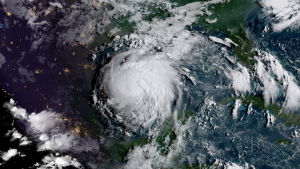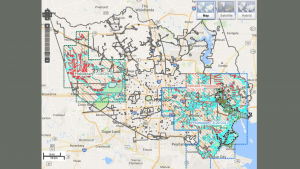Hurricane Harvey
By Michael FaginHurricaneWith 0 comments
Hurricane Harvey
Hurricane Harvey was the final ingredient needed to devastate Houston, combining with many including booming population growth, crumbling infrastructure, low elevations and stretching urbanization replacing freshwater wetlands (which once helped with drainage, at least during smaller storms.) It was still debated whether or not Tropical Storm Harvey was going to turn into a hurricane before he began travelling northward from Mexico’s coastal waters.
The timing of the tropical cyclone couldn’t have been worse for Houston, as late August and early September weather has proven to be optimal for hurricane production. Only some of the meteorological models – namely the NAM and European – were somewhat on the ball regarding what would happen next. Favorable atmospheric dynamics forced Category 1 Hurricane Harvey to very swiftly boom into a Category 4, as shown in this animation. The core remained close to the Gulf. Massive inflow convergence in the feeder band region out of happenstance often lined up with both the areas around Houston and areas upriver, including southeast Texas’ copious river-fed cotton fields.
While the high winds did devastate coastal areas, most of the damage came from Harvey remaining a Tropical Storm longer than any recorded Texas-impacting tropical cyclone, allowing catastrophic rainfall. About half of the region’s typical annual rainfall fell in four days. Some referred to the flooding as “biblical.” Space station footage from NASA well displays the tremendous moisture content associated with Harvey. It’s been said some of the affected areas only see weather events that wet once in a millennium.
Why Didn’t More Texans Evacuate?
Well before Harvey hit, Republican Governor Greg Abbott suggested to his fellow Texans that they should evacuate. He called Houston’s Democrat Mayor Sylvester Turner several times before landfall. However, the Mayor told Houstonians to stay put. Why?
An evacuation in 2005 from Hurricane Rita with dozens of people died on the road — in a horrific bus fire, in traffic accidents, of heat stroke. The Mayor later defended the non-evacuation order by explaining “you literally cannot put 6.5 million people on the road.” Harvey has raised important questions regarding the safety of living in a megacity. It revealed an utter lack of at least some vital disaster contingency plans, which undoubtedly is making citizens of cities like Los Angeles, Miami and New York shiver.
The Aftermath of Hurricane Harvey
The path of devastation started northeast of Corpus Christi with Category 4 winds tearing apart edifices along and near the coast. Many homes that weren’t fully devastated were damaged enough to lower their defenses against the incoming floodwaters.
The worst of it then headed inland and challenged the work of Texas’ civil engineers. Seven tornadoes spawned throughout East Texas. Fortunately, Houston’s Addicks and Barker reservoirs have held up, despite being in the middle of a renovation. Existing failsafes, however, were only capable of taking some of the edge off of the flooding. “Unprecedented” inundations led to boats on the streets filled with brave individuals and teams rescuing 10,000+ stranded and endangered Texans – the efforts of good samaritans, Federal government reinforcements, and many state and local governments from both Texas and far away, working together for the betterment of humanity.
Hurricane Harvey became the wettest storm in US history – the rainiest area, Cedar Bayou, having received 51.88’’, topping the previous record-holder: 1978’s Tropical Storm Amelia’s 48’’. Louisiana endured the falling of over 5.5 trillion gallons. 20 trillion unloaded on East Texas. A massive area around Houston with the square mileage of several Chicagos received at least 30’’.

Photo Credit FEMA flood map of Houston
The inundation quickly began to exit through riverways and low-lying passages such as I-10 – one of the busiest roads in America. Riverfronts have endured the most damage. Buffalo Bayou – the primary waterway through downtown Houston – reached a record 67.46’, drowning the surrounding areas as seen by this drone footage. The water spilled throughout downtown Houston, leading some to call it the “Gulf of Houston.” An interactive flood map is now available for 19 locations to enhance a sense of the damages.
Legendary flooding wasn’t anticipated by many of Houston’s industries, power and chemical plants. For example, overwhelmed by the rising waters, Arkema chemical plant exploded twice. Soon after, fumes from fires sent many to the hospital and triggered an evacuation of nearby residents. The tragedies of individuals and organizations are only beginning to be told.
Just before Houston was hit, many locals were fearing another Tropical Storm Allison, which did $9 billion in damages in 2001. Little did many realize how much more horrific Harvey would be, with destruction presently estimated at well over $90 billion. Early on, Moody’s estimated $97 billion in damages alone, with an extra $11 billion in lost output. Governor Abbott is requesting over $125 billion in Federal aid. A more recent estimate is $160 billion, with even higher future figures likely.
It is firmly the second most costly of all recorded Atlantic hurricanes. The present record holder, 2005’s Hurricane Katrina, had a final tally of $108 billion and it sounds like that will also be officially eclipsed after the waters recede and Harvey’s impact is fully assessed. It will take several weeks for many areas to dry out.
Over 185,000 homes were damaged or destroyed and 80% of Texans don’t have flood insurance. 42,000+ were in shelters as of Friday, Sep. 1. 364,000+ have already registered for help from FEMA.
Was Harvey Caused by Climate Change?
Some have argued that Harvey was a result of climate change. Hurricane Harvey was an atmospheric engine that assumed a precarious position. Calling it a result of climate change perverts the potential understanding of the meteorology because, at best, climate change may have slightly tweaked the details that led to his formation. It’s not that Harvey wouldn’t have existed independent of humans; the indescribably vague argument instead regards the intensities – wind speeds, rainfall, flash flooding, tornadic output, etc. The hypothesis also masquerades as if it draws from a thorough knowledge of how individual chemical changes affect those intensities but our understandings of atmospheric chemistry are new and, at best, truly just surface scratches of the whole.
Others have claimed that Harvey’s connection to global warming is the atmosphere’s higher capacity to hold water vapor. Water vapor capacity does increase when the temperature increases but the hypothesis depends on the entire Earth warming enough to notably influence Harvey. In fact a recent analysis by Dr. Cliff Mass from the University of Washington had this conclusion: “There is no evidence that global warming is influencing Texas coastal precipitation in the long term and little evidence that warmer than normal temperatures had any real impact on the precipitation intensity from this storm.”
It is true that, for a period, a changing climate may focus more precipitation on a specific area; but climate change has always been and always will be perpetual with or without man’s intervention. Many have already begun to argue that climate change is bringing up intense storms like Harvey more frequently. The worry is purely ironic because, days before Harvey, an all-time observed record of 142 months went by without a major hurricane impacting the continental US.
Written by Meteorologist Geoff Linsley
